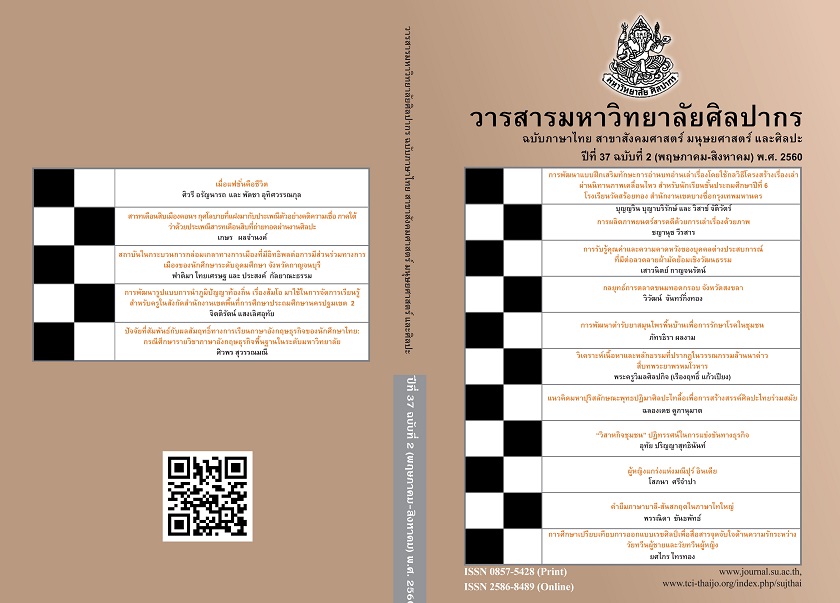เมื่อแฟชั่นคือชีวิต (WHEN FASHION ARE LIFE)
Main Article Content
Abstract
ในยุคสมัยแห่งสังคมออนไลน์ ส่งผลต่อการเกิดขึ้นของกลุ่มคนรุ่นใหม่ที่ต้องการแสวงหา และแสดงออกซึ่งความเป็นตัวตนมากยิ่งขึ้น การสร้างแบรนด์ และการออกแบบสร้างสรรค์สินค้าที่ดีนั้นจึงไม่อาจหยุดแค่ความสวยงาม ความแปลกใหม่ หรือประโยชน์ใช้สอยเท่านั้น หากแต่ต้องมีความเป็นแฟชั่นที่สามารถชี้นำสร้างการเรียนรู้และสะท้อนถึงรูปแบบการดำเนินชีวิต (Lifestyle) ทัศนคติความต้องการและเชื่อมโยงแบรนด์สินค้านั้นเข้ากับอารมณ์ของผู้บริโภค แฟชั่นแบรนด์มากมายจึงขยับเข้าสู่ตลาดสินค้าอื่น ๆ และนำไปสู่รูปแบบของการเป็นแบรนด์แฟชั่นไลฟ์สไตล์
Downloads
Download data is not yet available.
Article Details
Section
บทความประจำฉบับ
References
Chernev, A., Hamilton, R., and Gal D. (2011). Competing for Consumer Identity: Limits to Self-Expression and the Perils of lifestyle Branding. Journal of Marketing. [Online]. Retrieved March 20, 2014 from http://en.wikipedia.org/Lifestylebrand
David, K. (2005). Not Every Brand is a Lifestyle Brand. [Online]. Retrieved March 20, 2014 from http://www.businessweek.com.
Egan. (2005). The Luxury Market: Trying to Hit a Moving Target. Retrieved March 20, 2014 from http://knowledge.wharton.upenn.edu.
Gutman and Mills. (2006). Cross-national market segmentation in the fashion industry: A study of European, Korean, and US consumers. Retrieved October 15, 2013 from http://www.emeraldinsight.com/doi/pdfplus/10.1108/02651330710828022
Jariyawetch, P. (2010). Lifestyle Analysis (เจาะกึ๋นไลฟ์ สไตล์). [Online]. Retrieved May 20, 2015 from http://www.positioningmag.com/
Patcha, U. (2013). Fashion and Merchandise. Bangkok: Faculty of Fine and Applied Arts, Chulalongkorn University.
Reed, A. (2002). Social identity as a useful perspective for self concept based consumer Research. Psychology & Marketing, 19(1) : 235-266.
Sappington, D. (2003). “The Effects of Incentive Regulation on Retail Telephone Service Quality in the United States”. Review of Network Economics, 2(1) : 355-375.
Sophie, T. (2012). The Role of Visuals in Defining Fashion Lifestyle Brand Identity. Theses and dissertations. [Online]. Retrieved October 15, 2013 from http://digitalcommons.ryerson.ca/
Spaargaren, G., and VanVliet, B. (2000). Lifestyle, Consumption and the Environment: The Ecological Modernisation of Domestic Consumption. Environmental Politics, 9(1) : 50-57.
David, K. (2005). Not Every Brand is a Lifestyle Brand. [Online]. Retrieved March 20, 2014 from http://www.businessweek.com.
Egan. (2005). The Luxury Market: Trying to Hit a Moving Target. Retrieved March 20, 2014 from http://knowledge.wharton.upenn.edu.
Gutman and Mills. (2006). Cross-national market segmentation in the fashion industry: A study of European, Korean, and US consumers. Retrieved October 15, 2013 from http://www.emeraldinsight.com/doi/pdfplus/10.1108/02651330710828022
Jariyawetch, P. (2010). Lifestyle Analysis (เจาะกึ๋นไลฟ์ สไตล์). [Online]. Retrieved May 20, 2015 from http://www.positioningmag.com/
Patcha, U. (2013). Fashion and Merchandise. Bangkok: Faculty of Fine and Applied Arts, Chulalongkorn University.
Reed, A. (2002). Social identity as a useful perspective for self concept based consumer Research. Psychology & Marketing, 19(1) : 235-266.
Sappington, D. (2003). “The Effects of Incentive Regulation on Retail Telephone Service Quality in the United States”. Review of Network Economics, 2(1) : 355-375.
Sophie, T. (2012). The Role of Visuals in Defining Fashion Lifestyle Brand Identity. Theses and dissertations. [Online]. Retrieved October 15, 2013 from http://digitalcommons.ryerson.ca/
Spaargaren, G., and VanVliet, B. (2000). Lifestyle, Consumption and the Environment: The Ecological Modernisation of Domestic Consumption. Environmental Politics, 9(1) : 50-57.


